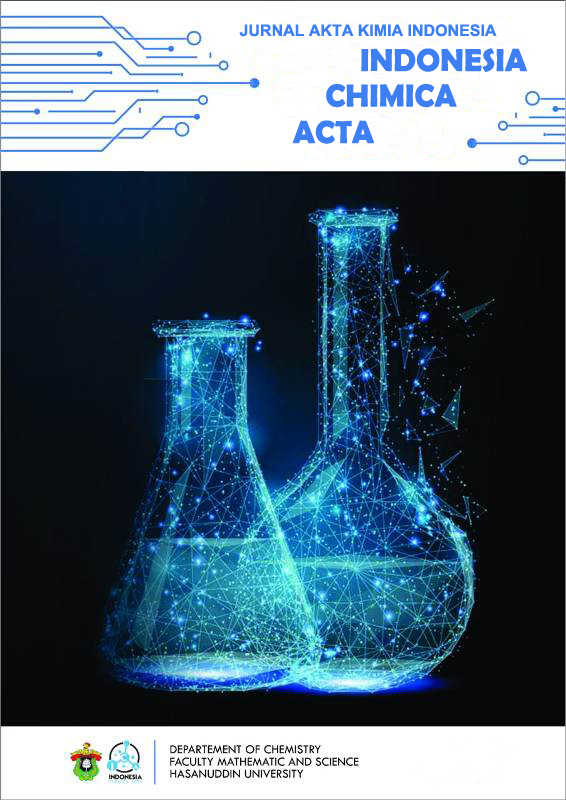Utilization of Ketapang Leaf Etil Asetic Fraction (Terminalia catappa) as A Bioreductor In Synthesis of Silver Nanoparticles and Analysis of The Antibacterial Properties
Abstract
References
Ankamwar, B., 2010, Biosynthesis of Gold Nanoparticles (Green- Gold) Using Leaf Extract of Terminalia Catappa, E-J. Chem., 7(4): 1334-1339.
Ariyanta, H. A., Wahyuni, S., and Priatmoko, S., 2014, Preparation of Silver Nanoparticles with Reduction Methods and Their Applications As Infection-causing Antibacterials, Indo. J. Chem. Sci., 3 (1): 1-6.
Babayi, H., Kolo, I., Okogun, J.I., Ijah, U.J.J., 2004, The antimicrobial Activities of Methanolic Extract of Eucalyptus camaldulensis and Terminalia catappa Against some Pathogenic Microorganisms, An Int. J. Niger. Soc. for Experiment. Bio, Nigeria, 16(2): 106-111.
Bakir, 2011, Development of Biosynthesis of Silver Nanoparticles Using Water Decoction of Bisbul Leaf (Diospyros blancoi) for Detection of Copper Ion (II) by Colorimetric Method, published thesis, (online), Department of Physics, FMIPA, University of Indonesia, Jakarta.
Feng, Q. L., Wu, J. Chen, G.Q., and Cui, F.Z. 2000. A Mechanistic study of the antibacterial effect of silver ions on Escherichia coli and Staphylococcus aureus. Journal of Biomedical Materials Research. 52(4): 662-668.
Gao, J., Tang, X., Dou, H., Fan, Y., Zhao, X., Xu, Q., 2004, Hepatoprotective Activity of Terminalia catappa L. Leaves and Its Two Triterpenoids, J. Pharm and Pharmacol, 56(1): 1-7.
Haryono, A., Dewi S, Sri Budi Harmami and Muhammad Randy, 2008. Synthesis of Silver Nanoparticles and Potential Applications. Journal of Industrial Research, 2 (3): 156-163.
Handayani W, Bakir, Imawan C, and Purbaningsih S., 2010, Potential Extracts of Several Plant Types as Reducing Agents for Silver Nanoparticle Biosynthesis, Biology National Seminar, Gadjah Mada University, Yogyakarta.
Jaziroh, S., 2008, Isolation and Identification of Active Compounds in n-Hexane Extract Ketapang Leaves (Terminalia catappa), Chemical Journal, 4 (2): 61-70.
Lembang, M.S., 2013, Synthesis of Silver Nanoparticles with Reduction Method Using Ketapang Leaves Bioreductor (Terminalia Catappa), Unpublished Thesis, Hasanuddin University Chemistry Study Program, Hasanuddin University.
Lu, Y.C., and Chou K.S., 2008, A Simple and Effective Route for Synthesis of Nano Silver Colloidal Dispersions, J. Chin. Ins.Chem. Eng., 39: 673-678.
Lin, Y., Kuo, Y., Shiao, M., Chen, C., Ou, J., 2000, Flavonoid Glycosides from Terminalia catappa L, J. Chin. Chem. Soc., 47(1): 253-256.
Mandasari, I., 2006, Isolation and Identification of Alkaloid Compounds in Ketapang Leaf Chloroform Extract (Terminalia Catappa Linn), unpublished Thesis, Department of Chemistry, Faculty of Mathematics and Natural Sciences, Diponegoro University, Semarang..
Mittal, K.A., Bhaumik, J., Kumar, S., Banerjee, U.C., 2014, Biosynthesis of silver nanoparticles: Elucidation of prospective mechanism and therapeutic potential, Journal of Colloid and Interface Science, 415: 39-47.
Montazer, M., Hajimirzababa H, Rahimi MK, and Alibakhshi S. 2012. Durable Anti-bacterial Nylon Carpet Using Colloidal Nano Silver. FIBRES & TEXTILES in Eastern Europe, 20(93): 96-101.
Pauly, G., 2001, Cosmetic, Dermatological And Pharmaceutical Use of An Extract of Terminalia catappa, United State Patent Application.
Ristian, I., Wahyuni, S., and Supardi, K. I., 2014, Study of the effect of Silver Nitrate Concentration on Particle Size in Silver Nanoparticle Synthesis, Indonesian Journal Of Chemical Science, 3 (1): 7-11..
Wardhani, L.K., and Sulistyani. N., 2012. Antibacterial Activity Test of Ethyl Acetate Extract of Binahong Anredera Scandens (L.) Leaf Against Flexneri Shigella and Thin Layer Chromatography Profile. Pharmaceutical Scientific Journal, 2 (1), 1-16.
Willems & Wildenberg V.D., 2005, Roadmap Report on Nanoparticle. Barcelona, Spain: W & W Españas.
Zakir, M., Sekine, T., Takayama, T., Kudo, H., Lin, M., dan Katsumura, Y., 2005, Technetium (IV) Oxide Colloids and The Precursor Produced by Bremmsstrahlung Irradiation of Aqueous Pertechnetate Solution, Journal Of Nuclear and Radiochemical Science, 6(3): 243-247.
Authors
This is an open access journal which means that all contents is freely available without charge to the user or his/her institution. Users are allowed to read, download, copy, distribute, print, search, or link to the full texts of the articles in this journal without asking prior permission from the publisher or the author.
Jurnal Akta Kimia Indonesia (Indonesia Chimica Acta) operates a CC BY-SA 4.0 © license for journal papers. Copyright remains with the author, but Jurnal Akta Kimia Indonesia (Indonesia Chimica Acta) is licensed to publish the paper, and the author agrees to make the article available with the CC BY-SA 4.0 license. Reproduction as another journal article in whole or in part would be plagiarism. Jurnal Akta Kimia Indonesia (Indonesia Chimica Acta) reserves all rights except those granted in this copyright notice.

